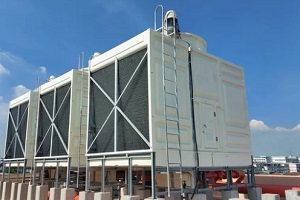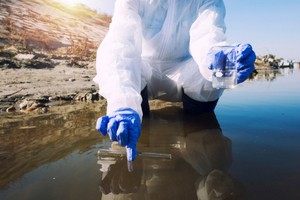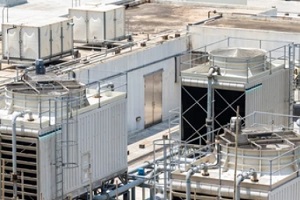 As summer approaches, building managers need to start preparing for the maintenance of their cooling tower systems. Cooling towers serve an essential role in regulating the temperature of a building, but they require regular maintenance to ensure they operate efficiently and effectively.
As summer approaches, building managers need to start preparing for the maintenance of their cooling tower systems. Cooling towers serve an essential role in regulating the temperature of a building, but they require regular maintenance to ensure they operate efficiently and effectively.
Neglecting cooling tower maintenance can lead to a range of problems, including reduced energy efficiency, equipment failure, and health risks. Relying on a water treatment service provider for your cooling tower can eliminate the manpower and time associated with the necessary preparation and maintenance your system needs.
This overview of cooling tower system maintenance will help you prepare for summer and detail how a service provider can help you maintain the efficiency of your building.
Why Focus on Summer Maintenance?
Although you should be conducting maintenance on your cooling tower year-round, summer is a particularly vital time to be thorough. As temperatures start rising, your cooling tower should be ready to operate on high gear.
Ongoing maintenance will help keep your building operating smoothly. Waiting for the heat to begin can result in having to halt productivity while the tower is repaired—or worse, cause the tower to fail due to a lack of maintenance.
Summer Maintenance by Timeline
There are many tasks to address when your cooling tower begins full operation this summer. It is easiest to break these responsibilities down by a timeline. Start planning now and create a schedule, delegate tasks, and create or reevaluate a documentation system to keep track of results.
Enlisting the services of a water treatment service provider will ensure all maintenance tasks, including documenting service and repairs for reporting, are completed without burdening your staff.
Daily Responsibilities
Every day, someone should check the water temperature. This is your most immediate window into identifying a problem, and it will indicate whether your process water is being cooled properly. If sensors need repair, your tower will not be maintaining the desired cooling.
 Also test the water quality for pH, conductivity and ORP (oxidation/reduction potential). You should have benchmarks or specific ranges to maintain for each of these readings which are usually determined by your water treatment service professional.
Also test the water quality for pH, conductivity and ORP (oxidation/reduction potential). You should have benchmarks or specific ranges to maintain for each of these readings which are usually determined by your water treatment service professional.
Your building personnel may be recording these readings themselves, or your water treatment controller may automatically read and log these for you. Make adjustments as necessary as these numbers will fluctuate with more frequent use of your cooling tower.
Weekly Responsibilities
Once a week, plan to conduct a full tower inspection, including your pumps. Inspect the tower fully, inside and out, and look for any potential mechanical issues or leaks. Any mechanical issues or water loss will lower the efficiency of your system.
A weekly dip slide/bacteria test is also mandatory to monitor legionella growth. This will keep you in compliance with local regulations (depending on your local jurisdiction), and mitigate the risk of legionella becoming airborne. If legionella is detected, you will need to file a report for compliance purposes if your local jurisdiction requires it, and corrective action will then be necessary.
Next, check the water treatment drum levels and products. It is important that there is a continuous feed of chemicals to your tower. The hotter it becomes in the summertime, the more your tower will run as the demand for cooling increases. The more water your tower uses, the more chemicals will be used.
Remember that your tower “makes up” for the water that is evaporated in the cooling process by adding fresh water which needs to then be treated. Replenish chemical levels as needed, or reach out to your water treatment provider to ensure that the next delivery is set to arrive prior to all chemicals being used up.
Finally ensure that you are physically checking that your water treatment equipment is functioning and pumping chemicals as intended. If your chemical pumps fail, the process water will not be treated properly and you are at risk of corrosion and legionella. Check to make sure all of your chemical pumps are primed and not leaking, and that your controller is properly feeding your tower.
Situation-Specific Responsibilities
Once you have streamlined your regular maintenance, make plans for unexpected events. For example, establish a vacation schedule if the person responsible for your normal maintenance tasks is planning to be gone. This should include time to train a new person to manage those responsibilities temporarily.
Your water treatment company will also need to conduct a once a year summertime hyperhalogenation. Because bacteria grows quicker during the warmer months, conducting a hyperhalogenation can be required to remain compliant if within a jurisdiction that requires it, but is highly recommended regardless. This is essentially a one time, highly concentrated chlorine treatment to help you remain free of bacteria through the summer season.
 You should plan in advance to schedule end of season tower cleaning once summer is coming to an end. This step is to prepare your tower for a reduction in use prior to the colder months and will help extend the longevity of your equipment.
You should plan in advance to schedule end of season tower cleaning once summer is coming to an end. This step is to prepare your tower for a reduction in use prior to the colder months and will help extend the longevity of your equipment.
Depending on your facility, the tower may need to be drained and properly powered down after your end of season tower cleaning. Remember that it is best practice to complete a tower cleaning twice a year, prior to and after the summer season.
Work with a Reputable Water Treatment Company for Cooling Tower Maintenance
Cooling tower maintenance should be thorough, but that does not mean it has to be complicated. The technicians at Tower Water have years of experience in maintaining cooling towers and ensuring that they function at peak performance without the risk of dangerous Legionella bacteria and other complications. Contact Tower Water by phone at 212.518.6475 or schedule a consultation online to speak with a cooling tower maintenance expert today.
